|
Eremopterix verticalis
(Grey-backed sparrowlark, Greybacked finchlark)
Grysruglewerik [Afrikaans]; Ruruworo, Tjowe (generic terms
for sparrowlark and Pink-billed lark) [Kwangali]; Grijsrug-vinkleeuwerik
[Dutch]; Moinelette à dos gris [French]; Nonnenlerche [German];
Cotovia-pardal-de-dorso-cinzento [Portuguese]
Life
> Eukaryotes >
Opisthokonta
> Metazoa (animals) >
Bilateria >
Deuterostomia > Chordata >
Craniata > Vertebrata (vertebrates) > Gnathostomata (jawed
vertebrates) > Teleostomi (teleost fish) > Osteichthyes (bony fish) > Class:
Sarcopterygii (lobe-finned
fish) > Stegocephalia (terrestrial
vertebrates) > Tetrapoda
(four-legged vertebrates) > Reptiliomorpha > Amniota >
Reptilia (reptiles) >
Romeriida > Diapsida > Archosauromorpha > Archosauria >
Dinosauria
(dinosaurs) > Saurischia > Theropoda (bipedal predatory dinosaurs) >
Coelurosauria > Maniraptora > Aves
(birds) >
Order: Passeriformes > Family: Alaudidae
> Genus: Eremopterix
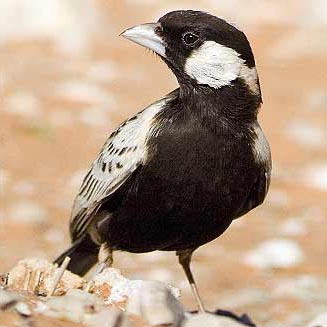 |
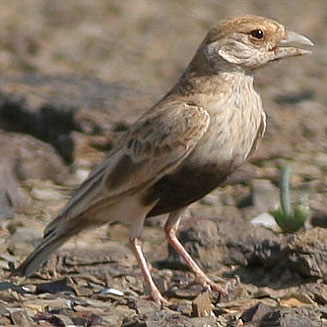 |
|
Grey-backed sparrowlark male, Kgalagadi Transfrontier Park, Northern Cape. [photo
Johann du Preez
©] |
Grey-backed sparrowlark female, Tanqua Karoo,
South Africa. [photo Trevor Hardaker ©] |
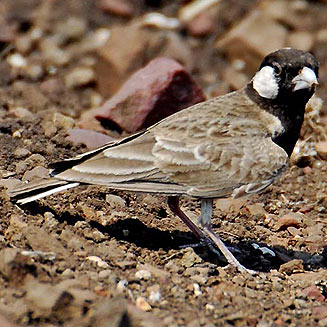 |
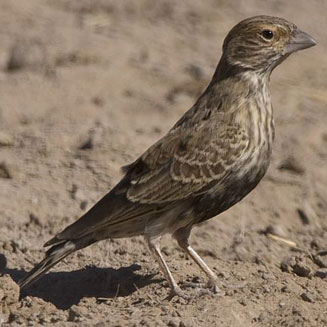 |
|
Grey-backed sparrowlark male. [photo Callie de Wet ©] |
Grey-backed sparrowlark juvenile, Beaufort West,
South Africa. [photo Trevor Hardaker ©] |
Distribution and habitat
Near-endemic to southern Africa, occurring from
south-western Angola and Zambia to Namibia, Botswana and South Africa,
marginally extending into Zimbabwe. It generally prefers semi-arid to arid open
habitats, such as sand or gravel plains punctuated by grass clumps and shrubs,
also recently burnt grassland, harvested cropland and fallow fields.
|
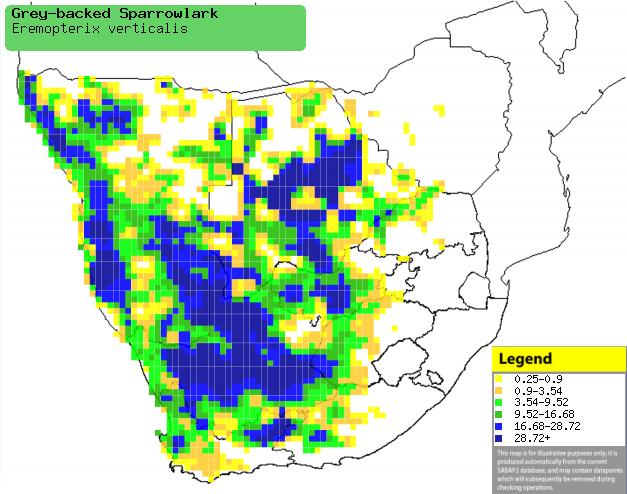 |
|
Distribution of Grey-backed sparrowlark in southern Africa,
based on statistical smoothing of the records from first SA Bird Atlas
Project (©
Animal Demography unit, University of
Cape Town; smoothing by Birgit Erni and Francesca Little). Colours range
from dark blue (most common) through to yellow (least common).
See here for the latest distribution
from the SABAP2. |
Predators and parasites
It has been recorded as prey of the
Falco chicquera
(Red-necked falcon).
Movements and migrations
It is extremely nomadic, moving in groups of up
to several thousand to areas with better rainfall and grass growth/
Food
It mainly eats seeds, doing most of its foraging in small
groups, pecking food items from the ground. The following food items have been recorded
in its diet:
- Seeds
- Atriplex lindleyi (Australian saltbrush, obtained by breaking open
fruit)
- grasses
- Brachiara glomerata
- Stipagrostis
- Schmidtia
- Aristida
- Eragrostis
- forbs
- Cleome
- Monsonia umbellata
- Hypertelis salsoides
- Arthropods
- Hodotermes mossambicus (Northern harvester termite workers and
alates)
- locusts (Orthoptera)
Breeding
- The nest (see image below) is built solely by the female in about 4-5
days, consisting of a cup built of small dry stems, leaves, feathery awns of
grasses and occasionally with fluffy Karoo rosemary seeds (Eriocephalus)
or wool. It is typically placed in an excavated hollow on a foundation of
stones, usually at the base of a shrub with the entrance facing south or
east, to maximise shade in the heat of the day.
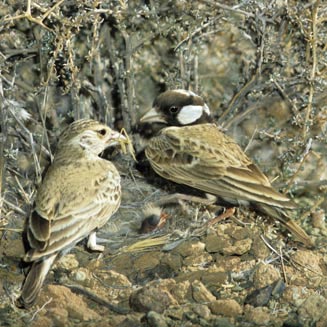 |
|
|
Grey-backed sparrowlark female (left), and
male (right), at nest with chick. |
|
- It is an opportunistic breeder, meaning that egg-laying season is
year-round. Laying dates usually coincide with rainfall and the onset of
grass growth - especially when bushman grass (Stipagrostis) develops
its feather awns.
- It lays 1-5 eggs, which are incubated by both sexes for about 9-11 days.
- The chicks are cared for by both parents, who mainly feed them
invertebrates such as grasshoppers and caterpillars. They eventually leave
the nestafter about 7-10 days (later if there has been rainfall), but only
taking their first flight at about 15-20 days old.
Threats
Not threatened.
References
-
Hockey PAR, Dean WRJ and Ryan PG 2005. Roberts
- Birds of southern Africa, VIIth ed. The Trustees of the John Voelcker
Bird Book Fund, Cape Town.
|
